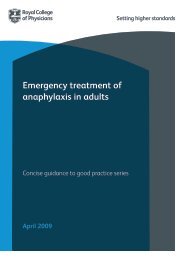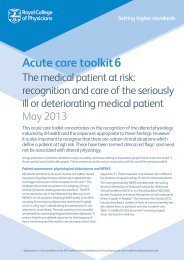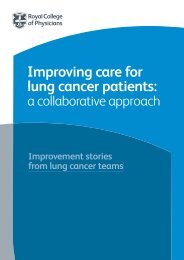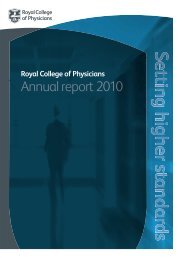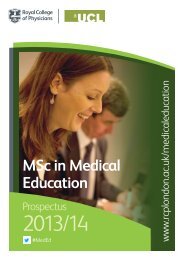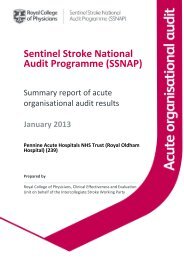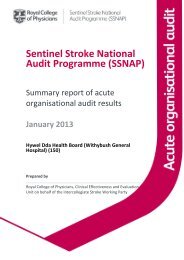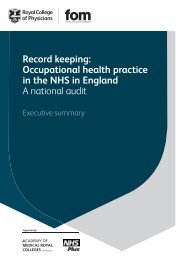Fifty years since Smoking and health - Royal College of Physicians
Fifty years since Smoking and health - Royal College of Physicians
Fifty years since Smoking and health - Royal College of Physicians
You also want an ePaper? Increase the reach of your titles
YUMPU automatically turns print PDFs into web optimized ePapers that Google loves.
8. Controlling access to tobacco<br />
products as a tobacco control strategy<br />
Pr<strong>of</strong>essor Richard Edwards<br />
University <strong>of</strong> Otago, New Zeal<strong>and</strong><br />
Controlling access to tobacco products<br />
Much <strong>of</strong> the focus <strong>of</strong> tobacco control over recent decades has been on reducing<br />
dem<strong>and</strong> for tobacco products. This is particularly the case for adult smoking, for<br />
which interventions – such as mass media campaigns, <strong>health</strong> warnings, tobacco tax<br />
increases, <strong>and</strong> controls on marketing – aim mainly to create triggers <strong>and</strong> a supportive<br />
environment for smokers to cut down <strong>and</strong>, ideally, to quit smoking. This contrasts<br />
with alcohol (<strong>and</strong> even more so with illicit drugs, where supply is generally the main<br />
intervention focus), where there is also attention to controlling the supply, for example<br />
through restricted opening hours <strong>and</strong> places <strong>of</strong> sale, <strong>and</strong> licensing <strong>of</strong> alcohol retailers.<br />
The major exception in the tobacco control arena is in the area <strong>of</strong> initiation, as laws to restrict<br />
the age <strong>of</strong> purchase <strong>of</strong> cigarettes are now the norm. However, reviews <strong>of</strong> international<br />
evidence suggest that these interventions have a modest effect, <strong>and</strong> even then only if<br />
rigorously enforced. 2,3 In Engl<strong>and</strong>, legislation to raise the legal age <strong>of</strong> purchase from 16 to<br />
18 <strong>years</strong> from October 2007 contributed to a substantial fall, by over 20 percentage points,<br />
in the proportion <strong>of</strong> regular smokers aged 11–15 who reported that they usually obtain<br />
cigarettes from a shop. However, in 2010 58% still reported shops to be their usual source <strong>of</strong><br />
cigarettes (see Fig 1 overleaf). 1<br />
Other indicators, such as reported diffi culty in purchasing cigarettes, trying to purchase<br />
cigarettes, <strong>and</strong> refusal <strong>of</strong> shops to sell cigarettes, also improved after the 2007 English<br />
legislation. Still, in 2010 42% <strong>of</strong> underage smokers who had tried to purchase cigarettes<br />
reported that they were always successful, <strong>and</strong> 89% <strong>of</strong> regular <strong>and</strong> 53% <strong>of</strong> occasional<br />
smokers reported that they had asked someone else to buy cigarettes for them (proxy<br />
purchase), <strong>and</strong> this was usually (around 90%) successful. A high proportion <strong>of</strong> purchases <strong>of</strong><br />
cigarettes were for packets <strong>of</strong> 10 (41%). 1 A great deal more needs to be done, therefore, to<br />
enforce existing legislation <strong>and</strong> further reduce availability <strong>of</strong> cigarettes to young people.<br />
© <strong>Royal</strong> <strong>College</strong> <strong>of</strong> <strong>Physicians</strong> 2012 23



